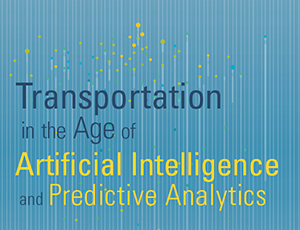Transformational Technologies: A State Government Perspective with Kirk Steudle
Before the traffic signal, a busy intersection could easily become a tangle of pedestrians, bicyclists, and vehicles vying for rights of way. The electric traffic signal, introduced in the early 20th century, was the first step in automating traffic flow, and is one of the first examples of automation in transportation.
“Automation has been continuing since that time, and it’s going to continue,” said Kirk T. Steudle, director of the Michigan Department of Transportation, who spoke recently as part of the U.S. DOT Volpe Center’s speaker series Transportation in the Age of Artificial Intelligence and Predictive Analytics.
Vehicle Automation: Safety First
The primary reason for vehicle automation, and the explosion of vehicle automation over the past few years, is not convenience, or efficiency, or novelty. From a road operations perspective, the reason for vehicle automation is safety, Steudle said.
There were 37,461 lives lost on U.S. roads in 2016, the most recent year of available data.
“If we know that the technology can save lives, why are we waiting to deploy it?” Steudle said. “We can choose to wait to deploy when we don’t have a family member in those numbers. When we have a family member in those numbers, waiting until next year is too long.”
Many highly automated functions are available on current vehicles. With adaptive cruise control, for example, radar keeps the vehicle a safe distance from a vehicle in front that slows down. But full automation, where a human is not needed to operate or monitor vehicle movement, is many years away, Steudle said.
Watch video highlights from Steudle's talk as part of U.S. DOT Volpe Center's 2018 speaker series, Transportation in the Afe of Artificial Intelligence and Predictive Analytics.
Balancing the Ideal and the Possible
“It’s easy for us in the technology transportation space to think forward,” Steudle said. “In my job, and my counterparts across the country, we have to balance what’s possible—what’s utopia 50 years from now—versus what’s possible next year. And how do you manage for the maybe 50 years in the middle?”
More than half of states allow autonomous vehicles on public roads, either by executive order or statute. Michigan is among those trying to limit regulatory hurdles to automated vehicle deployment.
“Michigan law allows for complete operations,” Steudle said. “If you can buy a vehicle and get FMVSS [Federal Motor Vehicle Safety Standards] approval, you can take it to the Secretary of State with your insurance certificate, you get a metal plate with white and blue letters, and off you go.”
The future of vehicle transportation may be fully automated. But that future isn’t happening tomorrow. By 2040, 30 percent of vehicles produced will be automated, Steudle said. That means 70 percent will likely have highly automated functions, but will also still have a brake pedal and steering wheel.
“We have to understand there is a transition—that as a public agency, we’ve got to provide infrastructure for both,” Steudle said. “This is going to be a difficult time. In the near-term, we still have a transportation network that has to serve those legacy vehicles.”

